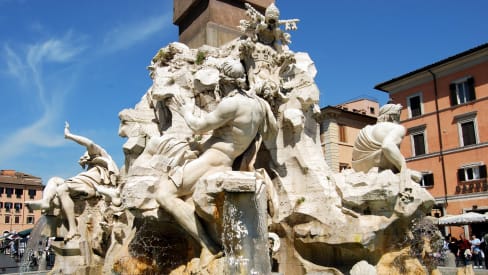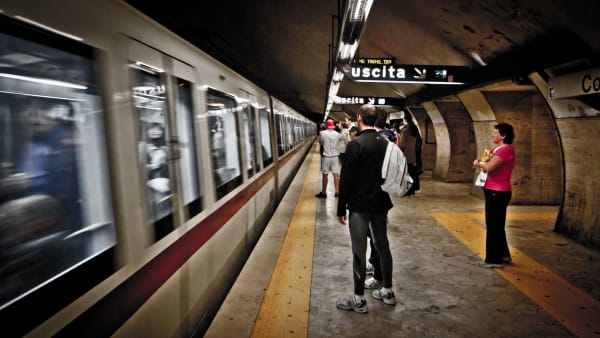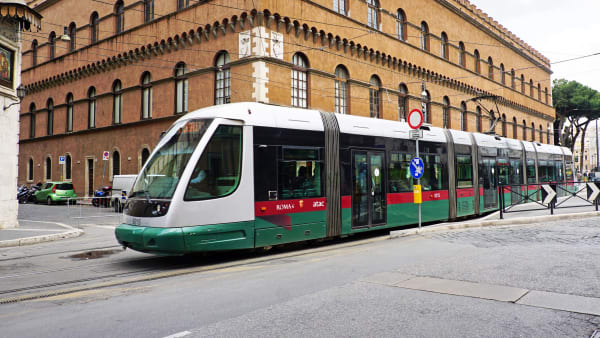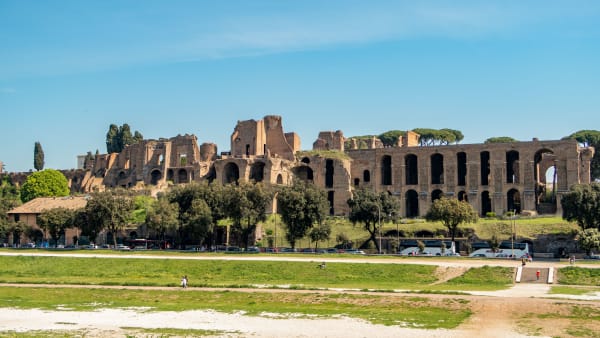Curiosities
Curiosities
Did you know that Piazza Navona used to be transformed into a lake every Saturday and Sunday in August? And that the square clearly bears traces of the rivalry between Bernini and Borromini? Discover more curiosities about this world-famous place!
The Pamphilj family
Given the importance of this family in the history of Piazza Navona and its monuments, it seems appropriate to take a closer look at the origins and role of this influential dynasty.
The Pamphilj family, of Umbrian origin, settled in Rome in the late 14th century and its members served several popes. In the mid-15th century, Antonio Pamphilj was the pope’s fiscal procurator and built a large fortune by purchasing houses and buildings near Piazza Navona.
This was the beginning of the social rise of the Pamphilj family, which became part of the great noble families of Rome and succeeded in securing for Girolamo the cardinal’s hat in 1610 during the next century.
However, it was the family’s second cardinal, Giovanni Battista, who was elected pope in 1644 under the name Innocent X, who created the family’s final fortune. During his pontificate (1644-1655), the Pamphilj obtained favors and became one of the richest and most powerful families in the city.
The pope’s brother, Pamphilio, transformed the houses in Piazza Navona into the uniform Palazzo Pamphilj. The pope, on the other hand, initiated the monumentality of the ancient and popular Piazza Navona itself, which, as we have seen in the previous chapters, was realized by Bernini (Fountain of the Four Rivers) and Borromini (St. Agnese in Agone).
Pamphilius’ widow, Olimpia Maidalchini, became the most powerful lady in Rome and ruled like a queen. Ambassadors, ecclesiastics, artists, merchants, politicians, and other important people gave her rich gifts to gain her favor and to be presented to the pope. Her court in the palace of Piazza Navona competed in splendor with that of her brother-in-law the Pope.
The story of Saint Agnes
As mentioned earlier in this article, according to legend, the church of Sant’Agnese in Agone in Piazza Navona was founded on the site where thirteen-year-old Agnese died a martyr’s death in 304 AD after a dramatic fate.
This unfortunate young woman was the daughter of a family of the Roman aristocracy, converted to Christianity, guilty of rejecting the son of the prefect of Rome, Sinfronius, and later indicted as a Christian.
Reportedly, the underage girl was undressed by customers of the brothel who intended to rape her. However, it seems that at that moment her hair miraculously melted and came down to cover her body almost completely, thus protecting her.
None of those present dared to violate her virginity after the only person who tried was electrocuted at her feet. As all attempts to burn her failed, she was finally stabbed to death and her throat was slit.
To keep alive the memory of this miracle and the martyrdom of this young Christian woman, a new church was built on the same site on the foundations of an early Christian basilica erected in the 8th century. This church was rebuilt in the 12th century by order of Callixtus II and later rebuilt as the Church of Sant’Agnese in Agone.
The six talking statues of Rome
Rome’s speaking statues—traditionally six—have been famous since the 16th century as the means by which locals made critical or sarcastic remarks about the pope and authorities in general.
The Romans made a habit of leaving messages against corruption and arrogance on these statues. Many popes tried to put an end to this tradition by moving the statues or guarding them day and night—but in vain.
The messengers who expressed the discontent of the people certainly didn’t belong to the Roman working class, the majority of whom were illiterate. Therefore, they had to be scholars, intellectuals, or members of Roman noble families, who were opposed to the papal hierarchy.
The six statues were named after the streets where they were located. They include: Pasquina at Piazza di Pasquino, Marforio in the courtyard of the Capitoline Museum, Madama Lucrezia at Piazza di S. Marco, Abate Luigi at Piazza Vidoni, il Facchino along Via Lata and il Babuino along Via del Babuino.
The Pasquino Statue
Pasquino is currently the only surviving statue, dating from the 3rd century, from the Hellenistic period. The name and origin of the statue remain a mystery. There are several theories about it such as: “Pasquino” was derived from the name of a barber, blacksmith, tailor, or shoemaker in the area where the statue was found. According to another theory, Pasquino was the owner of a restaurant located in Piazza di Parione (now Piazza di Pasquino).
Another legend states that it was a teacher whose students, after noticing some similarities with the statue, began to mock it by hanging papers with messages on its neck. In any case, the statue gives name to the aggressive and brutal satirical remarks about the ruling class and its members, also called “pasquinate”.
The sculpture was found in excavations in 1501. The face of the statue was damaged and it had neither arms nor legs. It’s difficult to say what it was supposed to represent but experts, however, identify the object as Menelaus carrying the body of Patroclus, both Greek warriors.
It seems that the statue originally graced the Circus Agonalis, which is now Piazza Navona. After its discovery, it was moved to its current spot, Piazza di Pasquino.
The rivalry between Bernini and Borromini
The history of art has seen rivalries and clashing visions between great artists. Think, for example, of Michelangelo and Leonardo, or Bernini and Borromini, who constantly challenged each other with their creations.
Gian Lorenzo Bernini and Francesco Borromini (who both lived in the mid-17th century) couldn’t stand each other and looked at each other’s work with envy. Their only goal was to continuously outdo each other with larger projects and their outcomes. Rome benefited from this rivalry, which unleashed unprecedented diligence and drive for beauty in the artists.
Bernini was born in Naples but spent most of his life in Rome. He was an incredible architect and painter, although he’s best known for his talent for sculpting. According to many historians, he was the true founder of Baroque sculpture.
Borromini, on the other hand, introduced figurative language to the Baroque style. His art consisted of sinuous lines and contrasts. Lonely and reclusive, he soon came into conflict with Bernini, who was extroverted and had good connections at the papal court. What resulted was fierce competition for commissions for the most important works in Rome.
Personal attacks
Several stories are told about the battle between Borromini and Bernini, of which the one about Piazza Navona is perhaps the most famous. It seems that the commission to build the Fountain of the Four Rivers had originally been awarded to Borromini but Bernini had managed to snatch it away with the help of his connections.
Moreover, two statues in the fountain are said to make fun of Borromini’s work (the Church of Sant’Agnese). The Rio de la Plata raises its arm to protect itself from the collapse of the church, while the Nile covers its head with a veil to avoid looking at the ugliness of the building. However, the fountain was built earlier than the church, so this story isn’t accurate.
What may be true is that Borromini wanted to express his disdain for Bernini’s fountain. After all, the statue of Saint Agnes that stands on the façade clearly looks away from the fountain that was already there at the time. But this is not the only anecdote about the rivalry between the artists.
It seems in fact that the commission for the construction of the Propaganda Fide palace, in Piazza Mignanelli, was taken away from Bernini in favor of his rival. Borromini, therefore, had two donkey ears sculpted in the corner near the house of Gian Lorenzo.
Bernini responded by modeling a phallus on the side of his rival’s house, pointing at Borromini and his team. Although these images were considered indecent and have been removed—this story appears to be based on facts.















